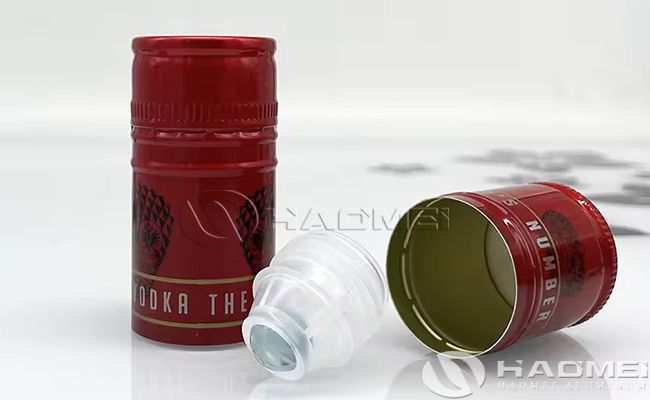Aluminum bottle cap with pourer (aluminum-plastic combination cap) is a composite structure bottle cap that combines aluminum outer cap and plastic inner pourer. It is widely used in the fields of medicine, wine, liquor, food, cosmetics, etc.

The following is analyzed from the dimensions of structural characteristics, functional advantages, application scenarios and production technology:
1. Structural characteristics
- Aluminum outer cap
It is made of aluminum alloy, such as 8011-H14 or 3105-H16, with a thickness of usually 0.20mm-0.23mm, a flat surface without scratches, and high mechanical strength and corrosion resistance. The outer cap is designed with an easy-to-tear or easy-to-break structure (such as upper tear type, side tear type), which is easy to open and can prevent reuse.
- Plastic inner pourer
It is based on polyethylene (PE) or polypropylene (PP), formed by injection molding or compression molding, directly contacts the bottle mouth and forms an elastic seal. The inner pourer has a smooth surface and can fit tightly with the glass or plastic bottle mouth to prevent liquid leakage. It is also chemically resistant and suitable for a variety of liquid medicines or food packaging.
2. Functional advantages
- High sealing and anti-leakage
The composite structure of the aluminum bottle cap and the plastic inner pourer achieves double sealing through mechanical pressing, and there is no leakage under a pressure of 1.2MPa, which is far higher than the 0.6MPa standard of ordinary plastic caps. The elastic deformation ability of the inner plug can compensate for the processing error of the bottle mouth and ensure the consistency of the seal.
- Anti-theft and anti-counterfeiting function
The easy-to-tear structure cannot be restored after damage, and the laser engraving or color printing on the surface of the aluminum caps can effectively prevent counterfeiting. Some high-end products use a three-piece structure (two-layer aluminum cap + plastic inner pourer) to further improve the anti-counterfeiting level.
- Environmental adaptability
The temperature resistance range of the aluminum plastic combination caps is -40℃ to 120℃. It can still maintain structural stability under cold chain transportation or high-temperature sterilization (such as 121℃ steam sterilization for 30 minutes), and the material recyclability rate is more than 95%, which meets environmental protection requirements.
3. Application scenarios of aluminium bottle caps with pourer:
- Pharmaceutical packaging
In the packaging of liquid preparations such as antibiotic bottles and infusion bottles, the moisture-proof and anti-oxidation properties of the aluminum-plastic combination caps can extend the shelf life of the drug by more than 30%. For example, after the vaccine bottle adopts this structure, the damage rate during refrigerated transportation is reduced to less than 0.1%.
- Food and cosmetics
When used for tamper evident wine caps, beverage caps and high-value-added foods (such as jam, honey, olive oil) or cosmetics (such as essences, creams) packaging, its anti-volatile properties can reduce the loss of contents by 15%-20%, while improving brand recognition through color printing and embossing processes.
- Industrial field
In the packaging of chemical reagents or lubricants, the chemical corrosion resistance of the aluminum-plastic combination caps can resist acid and alkali erosion, and its high-strength structure can withstand a 1.5-meter drop impact without damage, ensuring transportation safety.
4. Key points of production technology
Comparison between injection molding and compression molding
- Injection molding process: The material is heated to 250℃ and then melted before being injected into the mold. The molding cycle is short (3-5 seconds/piece), but the energy consumption is high, which is suitable for large-scale standardized production.
- Compression molding process: The material is heated to 180℃ and then extruded to form a semi-molten state, which reduces energy consumption by 30%, and the mold replacement is flexible, which is suitable for small batch orders of multiple varieties.
Key quality control points of aluminum bottle caps with pourer:
- Uniformity of aluminum cap thickness: The deviation must be controlled within ±0.01mm to avoid cracking caused by local stress concentration.
- Shrinkage rate of plastic inner plug: By adding 15%-20% talcum powder filler, the shrinkage rate is reduced from 2.5% to 1.2% to prevent separation from the bottle mouth.
- Composite strength: The peel strength of the aluminum cap and the plastic inner pourer must be ≥8N/15mm, which is achieved by optimizing the adhesive formula (such as modified epoxy resin).
MESSAGE
RECOMMENDED PRODUCTS
PRODUCTS
CONTACT US
Add:Zhengzhou, Henan, China
